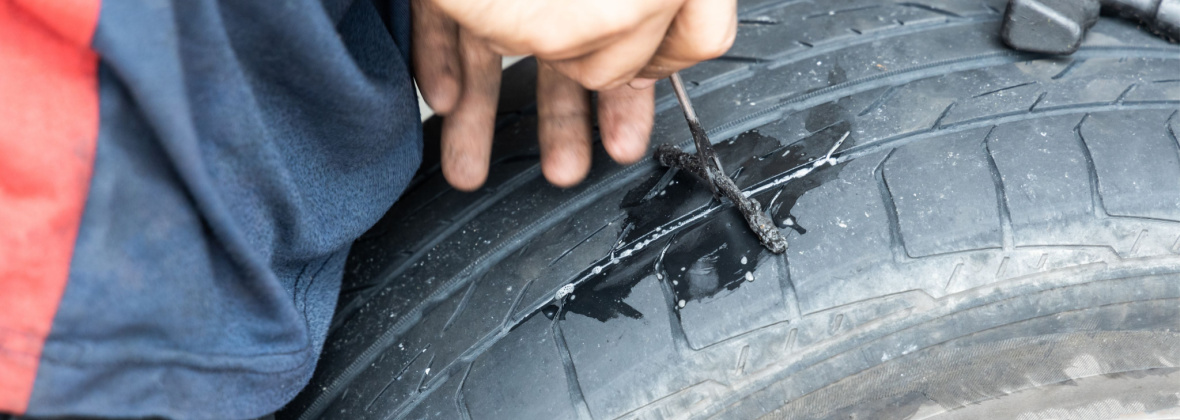Expert Overview to Tire Repair Service: Everything You Need to Know
Navigating the world of tire fixing can be an overwhelming task for numerous car owners. From recognizing the typical sources of tire damage to recognizing the complex steps included in patching up a leak, there is a wealth of knowledge to grasp. In this detailed guide, we will certainly unravel the complexities of tire repair, clarifying the different kinds of fixing packages available and offering beneficial insights into when it could be time to bid goodbye to a worn-out tire. Stay tuned as we dive deeper right into the subtleties of tire maintenance, equipping you with the necessary knowledge to ensure your tires stand the examination of time.
Usual Causes of Tire Damages
What are the common reasons that lead to tire damage, impacting automobile efficiency and safety and security? Tire damage can take place as a result of different variables, with among the primary factors being incorrect rising cost of living pressure. Under-inflated tires can trigger excessive heat buildup, leading to increased wear and prospective blowouts. Alternatively, over-inflated tires can lead to minimized grip, irregular wear, and a harsher ride.

One more common source of tire damage is insufficient walk deepness. Worn-out treads can compromise grip when driving, particularly in wet or slippery conditions, boosting the risk of crashes. Additionally, driving over potholes, debris, or sharp items can penetrate or create cuts in the tire, weakening its structure and potentially causing a flat.
In addition, improper wheel alignment and out of balance tires can additionally add to tire damages. Misaligned wheels can result in unequal wear patterns, while unbalanced tires can trigger resonances, influencing both the automobile's handling and the tire's durability. Normal maintenance checks and timely repairs can help alleviate these common reasons for tire damages, ensuring optimum car performance and safety and security.
Types of Tire Repair Kits
To resolve the after-effects of typical reasons for tire damages discussed previously, it is important to recognize the various kinds of tire repair service sets offered for automobile owners. There are primarily three sorts of tire repair service sets frequently used: plug kits, spot packages, and mix repair packages.
Plug packages are a fast and easy option for fixing little slits triggered by nails or screws. They contain a T-handle device and rubber plugs that can be put into the slit to seal the hole effectively. Patch sets, on the other hand, are more appropriate for larger leaks or cuts in the tire. These sets include a spot and adhesive product that is put on the internal cellular lining of the tire investigate this site to cover the damaged location securely.
Mix repair sets offer the advantage of containing both plug and spot elements, offering a detailed solution for a variety of tire damage scenarios. It is vital for car owners to familiarize themselves with these various kinds of tire repair service sets to be gotten ready for any kind of unforeseen tire concerns when traveling.

Steps to Repair a Tire Leak
Repairing a tire leak requires a systematic strategy and the right devices to make certain a secure and effective option. When faced with a punctured tire, the initial action is to safely pull over to a level, stable surface away from website traffic. Engage the car parking brake and location wheel chocks behind the tires to avoid any type go to this site of accidental rolling.
When to Replace a Tire
Identifying the ideal time for tire substitute requires an extensive evaluation of numerous vital aspects connected to tire wear and safety and security. One essential facet to think about is the tread depth. As tires put on down, the depth of the walk declines, impacting the tire's hold when driving. The majority of professionals suggest replacing tires when the tread depth reaches 2/32 of an inch to keep optimum traction (morris tire). Additionally, evaluating the tire for any signs of damage such as cuts, protrudes, or fractures is crucial. These concerns can compromise the structural stability of the tire, raising the threat of a blowout. Age is an additional considerable consider tire substitute. Also if the tread deepness shows up adequate, tires older than 6 years need to be thoroughly checked out, as the rubber can wear away with time, making the tire extra prone to failing. On a regular basis examining these variables and seeking advice from with a professional can assist establish when it's time to replace a tire for ideal safety click here for more info when traveling.

Tire Upkeep Tips for Longevity
After assessing essential factors connected to tire wear and safety and security, carrying out correct tire upkeep practices is important for maximizing the longevity of your tires. On a regular basis inspecting tire stress is critical, as underinflated tires can lead to enhanced wear and minimized gas efficiency.
Turning your tires at routine periods, commonly every 5,000 to 7,000 miles, advertises also tread wear across all tires. This method prolongs the life of your tires and guarantees optimal efficiency. Inspecting tires for indicators of damages, such as cuts, bulges, or slits, is additionally crucial for preserving tire durability. Driving practices play a significant duty in tire wear. Staying clear of sudden quits, sharp turns, and too much speeding can help preserve your tires and improve safety on the road. By following these tire maintenance ideas, you can optimize the lifespan of your tires and make sure a smooth driving experience (morris tire service).
Conclusion
To conclude, understanding typical sources of tire damage, utilizing the suitable tire repair service kits, adhering to correct actions to fix a tire puncture, knowing when to change a tire, and executing tire upkeep ideas are important for optimizing the long life of your tires. By remaining informed and proactive in addressing tire issues, you can make certain security when driving and lengthen the life-span of your tires.